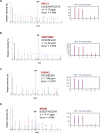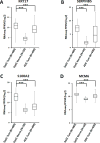Quantitative Proteomic Analysis of Optimal Cutting Temperature (OCT) Embedded Core-Needle Biopsy of Lung Cancer
- PMID: 28752479
- PMCID: PMC5693617
- DOI: 10.1007/s13361-017-1706-z
Quantitative Proteomic Analysis of Optimal Cutting Temperature (OCT) Embedded Core-Needle Biopsy of Lung Cancer
Abstract
With recent advances in understanding the genomic underpinnings and oncogenic drivers of pathogenesis in different subtypes, it is increasingly clear that proper pretreatment diagnostics are essential for the choice of appropriate treatment options for non-small cell lung cancer (NSCLC). Tumor tissue preservation in optimal cutting temperature (OCT) compound is commonly used in the surgical suite. However, proteins recovered from OCT-embedded specimens pose a challenge for LC-MS/MS experiments, due to the large amounts of polymers present in OCT. Here we present a simple workflow for whole proteome analysis of OCT-embedded NSCLC tissue samples, which involves a simple trichloroacetic acid precipitation step. Comparisons of protein recovery between frozen versus OCT-embedded tissue showed excellent consistency with more than 9200 proteins identified. Using an isobaric labeling strategy, we quantified more than 5400 proteins in tumor versus normal OCT-embedded core needle biopsy samples. Gene ontology analysis indicated that a number of proliferative as well as squamous cell carcinoma (SqCC) marker proteins were overexpressed in the tumor, consistent with the patient's pathology based diagnosis of "poorly differentiated SqCC". Among the most downregulated proteins in the tumor sample, we noted a number of proteins with potential immunomodulatory functions. Finally, interrogation of the aberrantly expressed proteins using a candidate approach and cross-referencing with publicly available databases led to the identification of potential druggable targets in DNA replication and DNA damage repair pathways. We conclude that our approach allows LC-MS/MS proteomic analyses on OCT-embedded lung cancer specimens, opening the way to bring powerful proteomics into the clinic. Graphical Abstract ᅟ.
Keywords: Biomarker; Drug target; Lung cancer; Pathology; Proteomics; Sample preparation.
Figures





Similar articles
-
Comprehensive proteome analysis of fresh frozen and optimal cutting temperature (OCT) embedded primary non-small cell lung carcinoma by LC-MS/MS.Methods. 2015 Jun 15;81:50-5. doi: 10.1016/j.ymeth.2015.02.008. Epub 2015 Feb 23. Methods. 2015. PMID: 25721092
-
Comparative LC-MS/MS analysis of optimal cutting temperature (OCT) compound removal for the study of mammalian proteomes.Analyst. 2013 Nov 7;138(21):6380-4. doi: 10.1039/c3an01121f. Analyst. 2013. PMID: 24051509
-
Quantitative Secretomic Analysis Identifies Extracellular Protein Factors That Modulate the Metastatic Phenotype of Non-Small Cell Lung Cancer.J Proteome Res. 2016 Feb 5;15(2):477-86. doi: 10.1021/acs.jproteome.5b00819. Epub 2016 Jan 25. J Proteome Res. 2016. PMID: 26736068 Free PMC article.
-
Proteomics technologies for the global identification and quantification of proteins.Adv Protein Chem Struct Biol. 2010;80:1-44. doi: 10.1016/B978-0-12-381264-3.00001-1. Adv Protein Chem Struct Biol. 2010. PMID: 21109216 Review.
-
Clinical Utility of Liquid Diagnostic Platforms in Non-Small Cell Lung Cancer.Oncologist. 2016 Sep;21(9):1121-30. doi: 10.1634/theoncologist.2016-0082. Epub 2016 Jul 7. Oncologist. 2016. PMID: 27388233 Free PMC article. Review.
Cited by
-
Microscaled proteogenomic methods for precision oncology.Nat Commun. 2020 Jan 27;11(1):532. doi: 10.1038/s41467-020-14381-2. Nat Commun. 2020. PMID: 31988290 Free PMC article.
-
From morphology to single-cell molecules: high-resolution 3D histology in biomedicine.Mol Cancer. 2025 Mar 3;24(1):63. doi: 10.1186/s12943-025-02240-x. Mol Cancer. 2025. PMID: 40033282 Free PMC article. Review.
-
Mapping the molecular signatures of diet-induced NASH and its regulation by the hepatokine Tsukushi.Mol Metab. 2019 Feb;20:128-137. doi: 10.1016/j.molmet.2018.12.004. Epub 2018 Dec 15. Mol Metab. 2019. PMID: 30595550 Free PMC article.
-
A simple method for sphingolipid analysis of tissues embedded in optimal cutting temperature compound.J Lipid Res. 2020 Jun;61(6):953-967. doi: 10.1194/jlr.D120000809. Epub 2020 Apr 27. J Lipid Res. 2020. PMID: 32341007 Free PMC article.
-
Nimbolide targets RNF114 to induce the trapping of PARP1 and synthetic lethality in BRCA-mutated cancer.Sci Adv. 2023 Oct 27;9(43):eadg7752. doi: 10.1126/sciadv.adg7752. Epub 2023 Oct 25. Sci Adv. 2023. PMID: 37878693 Free PMC article.
References
-
- Siegel RL, Miller KD, Jemal A. Cancer statistics, 2016. CA Cancer J Clin. 2016;66:7–30. - PubMed
-
- Travis WD. Pathology of lung cancer. Clin Chest Med. 2011;32:669–692. - PubMed
-
- Johnson DH, Fehrenbacher L, Novotny WF, Herbst RS, Nemunaitis JJ, Jablons DM, Langer CJ, DeVore RF, 3rd, Gaudreault J, Damico LA, Holmgren E, Kabbinavar F. Randomized phase II trial comparing bevacizumab plus carboplatin and paclitaxel with carboplatin and paclitaxel alone in previously untreated locally advanced or metastatic non-small-cell lung cancer. J Clin Oncol. 2004;22:2184–2191. - PubMed
-
- Pesch B, Kendzia B, Gustavsson P, Jockel KH, Johnen G, Pohlabeln H, Olsson A, Ahrens W, Gross IM, Bruske I, Wichmann HE, Merletti F, Richiardi L, Simonato L, Fortes C, Siemiatycki J, Parent ME, Consonni D, Landi MT, Caporaso N, Zaridze D, Cassidy A, Szeszenia-Dabrowska N, Rudnai P, Lissowska J, Stucker I, Fabianova E, Dumitru RS, Bencko V, Foretova L, Janout V, Rudin CM, Brennan P, Boffetta P, Straif K, Bruning T. Cigarette smoking and lung cancer–relative risk estimates for the major histological types from a pooled analysis of case-control studies. Int J Cancer. 2012;131:1210–1219. - PMC - PubMed
MeSH terms
Substances
Grants and funding
LinkOut - more resources
Full Text Sources
Other Literature Sources
Medical

